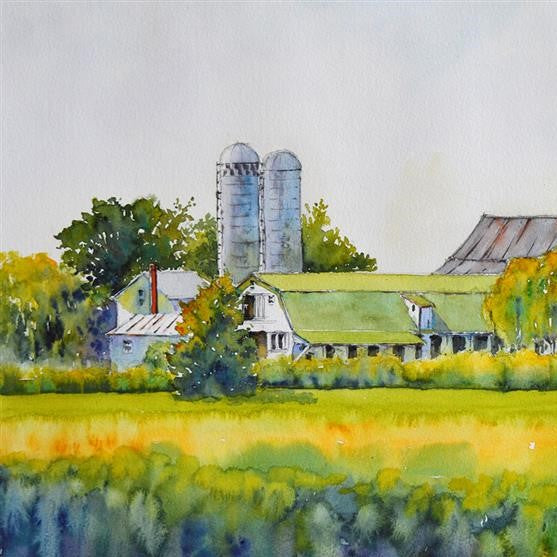How to Care for Your Watercolor Paintings



They say nothing lasts forever. To be honest we aren't quite sure who "they" are, although Maroon 5 and no fewer than half a dozen other vocal artists have expressed this sentiment through music titles. While by all indications the expression is a bit cliché, there is some truth to many clichés, including this one. However, we want our art to last forever, or at least through our lifetimes and for generations beyond, which is why we're expanding on a recent series about how to care for your art.
For many of us, there is just something special about watercolor paintings. Watercolor as a medium conveys a glow and moodiness that makes you feel almost as though you are experiencing the energy and sense of place within the scene it is depicting. Needless to say, as with any original artwork, protecting the beauty of your watercolor paintings is of the utmost importance for maintaining your artworks to appreciate for a lifetime.
When contemplating ways to protect our artworks, keep in mind that we are warding against various types of damage which can happen instantaneously or over time. According to Vicki Humphrey, head conservator for the National Museum of Australia, “The principal damage you get…….is physical and chemical, and often both in combination.” With this in mind, we're sharing some guidelines in the form of “Dos and Don'ts” for ensuring you maintain your watercolor paintings in pristine condition.
Dos and Don't: General Care for Your Watercolor Paintings
Many of our tips hold true for many different types of art. If you want to be extra cautious with your cherished artworks, keep in mind the following with regard to general handling.
DON'T touch the watercolor art directly.
DO wear nitrile gloves as an extra added protection if handling the artwork.
DO use support board as a mechanism for the artwork to rest upon if moving it from place to place.
Dos and Don'ts: Storing Your Watercolor Paintings
Watercolor paintings are a delicate medium that requires a heightened level of care. We'll address the matter of framing but if you have a watercolor that hasn't been framed yet, take care for storing to protect the paper and prevent damage to the corners and edges.
DO store a yet-to-be-framed artwork flat and horizontally. Artists often utilize a plan chest for storing their artwork, and while an entire chest may not be necessary, storage in a similar format is a good idea, such as a closed box, layering the artwork between pieces of acid-free tissues.
DON'T store unframed works in a plastic cover. The cover can damage the paint surface.
DON'T store unframed watercolors in dark and dusty places that fluctuate in temperature and often attract insects.
Dos and Don'ts: Framing Your Watercolor Paintings
Although framing art on paper might seem like a no-brainer, matting and framing is especially important for protecting watercolor paintings for a host of reasons. Artists who specialize in watercolors typically use untreated paper because the application is most effective. With this in mind, don't hesitate to procure the services of a professional framer for your watercolor. A credible framing business should be educated about the proper materials for each medium, but if you have any doubt, ask questions.
DO insist on acid-free materials for all paper products that will be in direct contact with your artwork.
DO ensure that your framer does archival framing.
DO protect artwork with high-quality glass as part of the framing process. There are three levels of glass that can be utilized in the framing of your watercolor painting: conservation clear, conservation reflection control, and museum glass.
DO ensure that the framing process includes buffering the actual artwork with a spacer between the glass surface and the artwork.
Dos and Don'ts: Hanging Your Watercolor Paintings
Exposure to certain elements such as direct sunlight will fade your watercolor artworks, and a host of other damaging elements exist that can result in harm to your art. After you receive a watercolor painting and are deciding what location to select to showcase your newest prized possession within your home, keep the following in mind.
DON'T hang your watercolor painting in a location with direct sunlight. While a high-quality glass finish is helpful, its protection only hovers around 50% as it relates to ultraviolet rays. If you can't avoid those rays altogether, consider shielding your beloved watercolor with acrylic plexiglass to mediate harmful exposure.
DON'T hang your watercolor painting in a room in which the primary lighting source is fluorescent light or incandescent lighting. These light sources emit a small amount of UV rays. Either switch out your lighting to LEDs or find another room in which to hang your watercolors where exposure is minimized.
DON'T display your art in a room which has a lot of exposure to oils or heat-emitting appliances. The kitchen is not a good choice for hanging your watercolor paintings, but never fear, you have other options.
DON'T display your art in a room in which humidity and moisture are common environmental elements. These factors can cause molding and other damage to an artwork. In other words, your bathroom might not be the best place to display original watercolors.
DO consider all the environmental elements such as temperature. Although your HVAC can mediate some of these factors, don't let your room temperatures fluctuate dramatically.
We hope you’ve found value in these tips about caring for your watercolor paintings. If you’re in the market for additional watercolor works, check out our selection of original watercolors as well as our variety of new art posted weekly.





